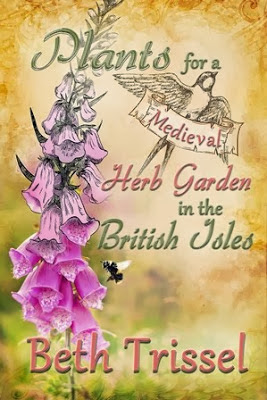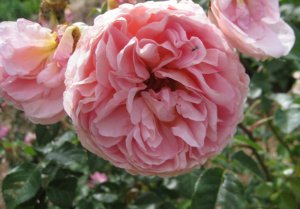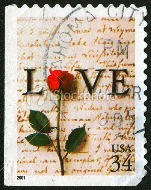18th century botanist Sir John Hill, also an apothecary, playwright, actor, novelist, and journalist, was quite an accomplished gentleman. Sir John is also among the most vilified men in Georgian England for his attacks on the Royal Society, with whom he was at odds. Disappointed by the society’s refusal to elect him a fellow, coupled with his disapproval of their scientific standards, Hill wrote many strongly worded reviews of the lauded society. And they weren’t the only ones to come under fire by Hill, outspoken to a fault. He was attacked in turn, but onto his charming and informative work, The Family Herbal.
Hill states his herbal is intended to inform those who live in the country and are desirous of being useful to their families and friends, or charitable to the poor in relief of their disorders, of the virtues of wild plants, and describes his book as, ‘An account of all those English plants which are remarkable for their virtues, and of the drugs which are produced by vegetables of other countries: with their descriptions and their uses, as proved by experience.’
He prefaces his herbal with detailed explanations as to which part of the plant is used and the steps in preparing the desired form for administering its healing properties.. Fascinating stuff. I love Hill’s many references to the ‘charitable lady’ who is concocting herbal medicines for her family or community and he gives painstaking instructions and recipes for making juices, infusions, decoctions, distilled waters, cordials, tinctures, conserves, syrups, oxymels, vinegar of squills, ointments, plaisters (plasters), essential oils…
He says, “The virtues of different plants residing principally in certain parts of them, and those different according to the nature of the herb, these several parts are to be selected, and the rest left: and these are in some to be used fresh and just gathered; in others, either necessity, or the natural preference, make it proper to dry and preserve them.
In some only the leaves are to be used; in others the whole plant cut from the root: in others the flowers only; in others the fruits; in others the seeds; in some the roots; and of some trees the barks; some the woods; and only the excrescences of others: while some vegetables are to be used entire, whether fresh gathered, or dried and preserved.
When the whole plants dies, (in winter), the root is seldom of any virtue; but when the root remains for many years and sends up new shoots in the spring, it commonly has great virtue.”
He’s speaking of perennials and recommends taking the leaves growing from the root rather than the stalk, “for they are more juicy, and for many purposes much better.”
 “When the juice of the leaves of any plant is required, these are the leaves from which it is to be pressed…if fresh, they should be cut up close to the root, and only shook clean, not washed; for in many, that carries off a part of the virtue: they are to be cut into the pot. If they are to be dried, the same caution is to be used…when herbs are to be used fresh, it is best not to take them entire, but only to cut off the tops; three or four inches long…the tops of the plants thus gathered are always preferable to the whole plant for immediate use.
“When the juice of the leaves of any plant is required, these are the leaves from which it is to be pressed…if fresh, they should be cut up close to the root, and only shook clean, not washed; for in many, that carries off a part of the virtue: they are to be cut into the pot. If they are to be dried, the same caution is to be used…when herbs are to be used fresh, it is best not to take them entire, but only to cut off the tops; three or four inches long…the tops of the plants thus gathered are always preferable to the whole plant for immediate use.
When the entire herb is to be dried, the season for gathering it is when the flowers are budding; and the time of day must be when the morning dew is dried away…for if they be cut wet, herbs will not dry well. And if they be cut at noon day, when the sun has made the herbs flag, they will not have their full power.”
He recommends either hanging the herbs in bunches to dry in an airy room in good, not damp, weather, or spreading them upon the floor, tables, (or drying racks) and turning them until they are ready. Good air circulation is key. Then he suggests storing them between sheets of paper in drawers. Closets and cupboards would also work. Make certain you do not store them where it is damp or overly hot. He advises drying flowers, such as lavender, rosemary, and red rosebuds in their prime in much the same method and storing them. However, he adds many flowers used in medicine are best fresh, but as they are available for only a short time of year, the best method of preserving them is in the form of syrups and conserves.
 Regarding seeds, these are all to be used dry and gathered when perfectly ripe. Among the roots, he says, “a great many are to be used fresh, but a greater number are best dried. The best season for gathering roots for drying is in the earlier part of the spring…when the leaves are just going to bud: the juices are rich, fresh, and full.”
Regarding seeds, these are all to be used dry and gathered when perfectly ripe. Among the roots, he says, “a great many are to be used fresh, but a greater number are best dried. The best season for gathering roots for drying is in the earlier part of the spring…when the leaves are just going to bud: the juices are rich, fresh, and full.”
He directs that roots are to be wiped clean, but not washed, and prepared for drying. Depending on the kind and size, they may be sliced cross-wise and dried on hair cloth (wiry fabric woven especially from horsehair or camel’s hair) stretched across a frame, frequently turned, and thoroughly dried before storing. The juicier roots are to be strung upon a line to dry by drawing a needle threaded with a small twine through them, after they’ve been cut length-wise, quartered, and the heads cut off. If the root has a hard woody center, this is to be discarded.
“The barks of trees make but a small part of English drugs, and most are best fresh.” But Hill goes on to say, they may be preserved and will retain their virtues when dried by cutting them into moderate pieces and stringing them up in the same manner as the roots.
 “There is no form of medicines sent from the apothecary, which may not be prepared from the herbs of our own growth in the same manner. Electuaries (medicinal pastes incorporated with sweeteners to hide the taste) may be made with the powders of these barks, roots, and seeds, with the conserve of flowers, and of the tops of fresh herbs; and syrups, made from their juices and infusions…”
“There is no form of medicines sent from the apothecary, which may not be prepared from the herbs of our own growth in the same manner. Electuaries (medicinal pastes incorporated with sweeteners to hide the taste) may be made with the powders of these barks, roots, and seeds, with the conserve of flowers, and of the tops of fresh herbs; and syrups, made from their juices and infusions…”
“Juices are to be expressed from (fresh) leaves or roots; and in order to do this, they are first to be beaten in a mortar.” He particularly recommends this method, but cautions, “the juices may have an ill taste, or be cold upon the stomach, or otherwise disagree with it, there are methods to be used to make them sit better upon it. Allow the herb juice, fresh drawn, to settle and grow clear: a little sugar may be added in beating the herb.” Or the juice of a Seville orange. To the roots, he suggests adding a little white wine in the bruising, also a little sugar and powdered ginger.
 “Infusions are naturally to be mentioned after the juices, for they are in many cases used to supply their place. Juices can only be obtained from fresh plants, and there are times of the year when the plants are not to be had in that state.” He goes on to recommend recourse to those plants that have been dried and preserved, either by yourself or purchased from the shop. Cut the desired herb into pieces and pour hot water over it to extract the medicinal qualities. *Infusions may also be made from fresh herbs. “Infusions are of two kinds. They are either prepared in quantity to be drank cold; or they are drank as they are made, in the manner of tea. This manner is best, but people will not be prevailed upon to do it, unless the taste of the herb be agreeable; for the flavor is much stronger hot, than it is cold.” He suggests a little sugar.
“Infusions are naturally to be mentioned after the juices, for they are in many cases used to supply their place. Juices can only be obtained from fresh plants, and there are times of the year when the plants are not to be had in that state.” He goes on to recommend recourse to those plants that have been dried and preserved, either by yourself or purchased from the shop. Cut the desired herb into pieces and pour hot water over it to extract the medicinal qualities. *Infusions may also be made from fresh herbs. “Infusions are of two kinds. They are either prepared in quantity to be drank cold; or they are drank as they are made, in the manner of tea. This manner is best, but people will not be prevailed upon to do it, unless the taste of the herb be agreeable; for the flavor is much stronger hot, than it is cold.” He suggests a little sugar.
To prepare a cold infusion to be given over a period of time: “A stone jar is to be fitted with a close cover; the herb, whether fresh or dried, is to be cut to pieces; and when the jar has been scalded out with hot water (I assume to sterilize it), it is to be put in: boiling water is then to be poured upon it; and the top is to be fixed on; it is thus to stand for four, five, six hours, or the whole night, according to the nature of the ingredient, and then poured off, clear.”
More of some plant is required for some infusions than others: “For the most part, three quarters of an ounce of a dried plant, or two ounces of the fresh gathered.” Again, he says a little sugar or white wine will help the medicine go down, and possibly a little lemon juice if available. *Avoid the use of metal in preparing infusions, except for boiling the water.
 “Decoctions are contrived to answer the purpose of infusions upon plants which are of so firm a texture that they will not easily yield forth their useful parts. In these, the ingredients are to be boiled in the water.” In an infusion, the boiling water is poured over the plant, like brewing tea, while a decoction requires boiling the ingredients to extract their properties. He says, “In general, leaves, flowers, and entire plants whether fresh or dried, are used in infusions; the roots and bark in decoctions.” So decoctions are for the tougher materials. When fresh roots are used, he advises first cutting them into thin slices. Fresh bark should be shaved down to better prepare it.
“Decoctions are contrived to answer the purpose of infusions upon plants which are of so firm a texture that they will not easily yield forth their useful parts. In these, the ingredients are to be boiled in the water.” In an infusion, the boiling water is poured over the plant, like brewing tea, while a decoction requires boiling the ingredients to extract their properties. He says, “In general, leaves, flowers, and entire plants whether fresh or dried, are used in infusions; the roots and bark in decoctions.” So decoctions are for the tougher materials. When fresh roots are used, he advises first cutting them into thin slices. Fresh bark should be shaved down to better prepare it.
 When dry ingredients are used, the roots and bark are best pounded to pieces. Herbs and flowers (if part of the mixture) are best added toward the end of the decoction, requiring less time. “Let the ingredients of the decoction stand in cold water for twelve hours, before it is set on the fire, and then it should be heated gradually, and afterwards kept boiling gently as long as necessary: and this is to be proportioned to the nature of the ingredients. Generally, a quarter of an hour is sufficient, sometimes much longer is necessary. They are to be strained off while they are hot, pressing them hard, and the liquor set by to cool: when they are thoroughly cold, they are to be poured off clear from the settlement, for they always become clear as they cool, and sweetened with a little sugar. Also, it is proper to add to them a little white wine, as to the infusions.”
When dry ingredients are used, the roots and bark are best pounded to pieces. Herbs and flowers (if part of the mixture) are best added toward the end of the decoction, requiring less time. “Let the ingredients of the decoction stand in cold water for twelve hours, before it is set on the fire, and then it should be heated gradually, and afterwards kept boiling gently as long as necessary: and this is to be proportioned to the nature of the ingredients. Generally, a quarter of an hour is sufficient, sometimes much longer is necessary. They are to be strained off while they are hot, pressing them hard, and the liquor set by to cool: when they are thoroughly cold, they are to be poured off clear from the settlement, for they always become clear as they cool, and sweetened with a little sugar. Also, it is proper to add to them a little white wine, as to the infusions.”
 Distilled Waters: In short, these are herbs, or spices, that have been distilled (in an actual still which Hill assumes you have on hand) either with water alone or the addition of spirit (he recommends ‘molasses spirit’ which is rum made from molasses). The ‘waters’ with spirits are referred to as cordials. One recipe calls for three pounds of dried mint put into the still with four gallons of water and two gallons to be distilled off. Cinnamon water is a cordial made with a pound of cinnamon, a gallon of water and a gallon of spirit, with one gallon to be drawn off, or distilled. Both the mint water and cinnamon cordial are recommended for sickness in the stomach, and the list of recipes goes on for treating various complaints.
Distilled Waters: In short, these are herbs, or spices, that have been distilled (in an actual still which Hill assumes you have on hand) either with water alone or the addition of spirit (he recommends ‘molasses spirit’ which is rum made from molasses). The ‘waters’ with spirits are referred to as cordials. One recipe calls for three pounds of dried mint put into the still with four gallons of water and two gallons to be distilled off. Cinnamon water is a cordial made with a pound of cinnamon, a gallon of water and a gallon of spirit, with one gallon to be drawn off, or distilled. Both the mint water and cinnamon cordial are recommended for sickness in the stomach, and the list of recipes goes on for treating various complaints.
Some additional ones mentioned are: pennyroyal water for treating hysterics and to promote the menses (possibly the woman is hysterical because she suspects an illicit pregnancy), aniseed water for soothing colic and lavender water for palsy. The ‘charitable lady’ is expected to keep an assortment of curative waters, cordials, and tinctures at the ready, “for a tincture will contain more or less of the virtue of every one of these (plants) and be convenient, where powder or decoction could not be given.”
To make a tincture (given in drops): “Two ounces of the ingredient is to be cut to thin slices, or bruised in a mortar, and put into a quart of spirit; it is to stand a fortnight in a place a little warm, and be often shook; at the end of this time, it is to be taken out, strained off, and made to pass through a funnel, lined with whitish brown paper, and put up with the name of the ingredient.”
Hill advises keeping the tinctures of many roots on hand. He also gives recipes for a making variety of tinctures from imported ingredients including cardamom seeds, cinnamon, ginger, long pepper (also called Indian long pepper, is a flowering vine cultivated for its fruit, which is usually dried and used as a seasoning), dried orange peel, myrrh, saffron, camphire (an old spelling of camphor)…and the list goes on.
Not to neglect Hill’s in-depth instruction for the preparation of conserves, syrups, ointments and plaisters (plasters), adding that bruised herb leaves make the best plaisters. (*His spelling)
 Conserves are made of the tender tops of herbs beaten up with three times their weight in sugar. In a similar way, the flowers of rosemary, mallows, archangel, lavender, and red rose buds may be made into conserves. Hill mentions conserves made of rosehips and sloes (also used in making sloe gin). He says to gather fully ripe hips and set them by in the cellar until soft, then lay the hips on the back of a large hair sieve with a dish placed underneath. They are to be broken with the hand or a wooden pestle and rubbed about until all the soft matter is forced through the cloth, leaving the seeds and skins behind. The pulp is beaten with twice its weight in sugar. Sloes are gathered when moderately ripe. These are set over the fire in water until they are softened, but not until the skins burst. Then they are to be laid upon a sieve and the soft matter driven through. A conserve is made by beating this pulp with three times its weight in sugar.
Conserves are made of the tender tops of herbs beaten up with three times their weight in sugar. In a similar way, the flowers of rosemary, mallows, archangel, lavender, and red rose buds may be made into conserves. Hill mentions conserves made of rosehips and sloes (also used in making sloe gin). He says to gather fully ripe hips and set them by in the cellar until soft, then lay the hips on the back of a large hair sieve with a dish placed underneath. They are to be broken with the hand or a wooden pestle and rubbed about until all the soft matter is forced through the cloth, leaving the seeds and skins behind. The pulp is beaten with twice its weight in sugar. Sloes are gathered when moderately ripe. These are set over the fire in water until they are softened, but not until the skins burst. Then they are to be laid upon a sieve and the soft matter driven through. A conserve is made by beating this pulp with three times its weight in sugar.
“Syrups are made of many ingredients: they may be made of any infusion with sugar added to it in a due quantity.” He says, “the liquor (liquid) of which a syrup is to be made may be the juice of some herb or fruit, or a decoction, or an infusion; whichever it be, let it stand until quite clear; then to every wine pint of it, add a pound and three quarters loaf of sugar. First beat to a powder: put the sugar and the liquor together into an earthen pan that will go into a large saucepan; put water in the saucepan and set it over the fire. Let the pan stand in it til the sugar is perfectly melted, scumming it all the time; then as soon as it is cold, it may be put up for use and will keep the year round without danger.” He also refers to using honey instead of sugar for some syrups.
 His recipe for ‘Honey of roses’ sounds particularly delightful.
His recipe for ‘Honey of roses’ sounds particularly delightful.
“Cut the white heels from some red rose buds, and lay them to dry in a place where there is a draught of air; when they are dried, put half a pound of them into a stone jar, and pour on them three pints of boiling water; stir them well, and let them stand twelve hours; then press off the liquor (liquid) and when it has settled, add to it five pounds of honey; boil it well, and when it is of the consistence of thick syrup, put it by for use. It is good against mouth sores, and on many other occasions.” (Which means it has many other uses.)
Onto recipes for oxymels (a mixture of honey, water, vinegar, and spice, boiled to a syrup). Hill favors an oxymel of garlic prepared with fennel and caraway seeds and honey. Vinegar of squills (lily-like plants) made with vinegar and honey, and the garlic oxymel, are both recommended for asthma.
The simplest ointments are made with herbs and hog’s lard. The lard is melted and the herbs are chopped to pieces and thrown into it. They are boiled until the leaves begin to feel crisp, then the lard is strained off. Hill also lists exotic bases for unguents such as oils, wax, resin, and gives his favorite combinations. Some include pitch and turpentine.
 “Of the same nature with the ointments, are, in some degree, the oils made by infusion of herbs and flowers in common oil.” Which means, essential oils are prepared in a similar manner to ointments. For example, “Oil of elder is made of a pound of elder flowers, which are to be put into a quart of olive oil, and boiled til they are crisp, and the oil is to be strained off.”
“Of the same nature with the ointments, are, in some degree, the oils made by infusion of herbs and flowers in common oil.” Which means, essential oils are prepared in a similar manner to ointments. For example, “Oil of elder is made of a pound of elder flowers, which are to be put into a quart of olive oil, and boiled til they are crisp, and the oil is to be strained off.”
Hill adds several more ‘waters’ he considers essential: Lime, blue, and alum, with recipes.
For a julep, he recommends six ounces of one of the ‘simple waters’, two ounces of one of the compound waters, or those made with spirit, two drams of syrup, and fifty drops of a tincture. “Thus for an hysteric julep, let the simple water be pennyroyal, the strong water the strong pennyroyal, the syrup that of saffron, and the tincture of castor.” *Please note, the use of this much pennyroyal concerns me given the medical cautions surrounding strong infusions of this herb, so bear that in mind.
He confides, the apothecaries will not be pleased with his disclosing “the mysteries of their profession, but the public good is of more consequence than their pleasure.”
And there you have it!




























































